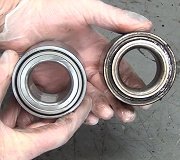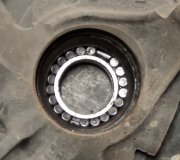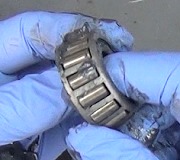The motor does not have any sludge. When I first put the motor in (Bought the vehicle with a spun bearing) it had a minor sludge issue. None in the oil pan, but a very little in the valve cover. I did oil changes every 1000 miles to resolve this issue.
I did not remove the bearings and check the clearances with plastigage yet, because this is my last resort.
Do Bearings really just all of a sudden loose oil pressure? I thought that bearings would gradually wear out, causing the pressure to gradually go down little by little until they need replaced.
Also, if you simply would like to replace engine bearings if there is not a huge oil pressure problem. Instead of running plastigage, can you install Standard bearings and be OK? Or does the crank wear out with the bearings, leading to having to resurface the crankshaft?
========
The motor I installed had 102,000 miles on the odometer. I've put about 10,000 miles on it since the install.
Done the following in the 10,000 miles:
Transmission filter
Transmission shift solenoids / Valve body
Distributor Cap, rotor, Coil, Pickup
Igniter
Spark Plugs, wires
IACV
EGR
TPS
VSV
All Vacuum lines
Throttle Body cleaning
Alternator
Timing Belt
Timing tensioner
Timing idler pulley
Oil pump gasket and O-Ring
Water Pump
Flushed radiator
Numerous oil changes
Brakes All around
Rear Main Seal
Differential Drain / Refill
Axles (both sides)
Struts
Strut tower bushings
Control Arm Bushings
Sway bar bushings
Brake fluid change
rear Wheel bearings
Front wheel bearings
inner/outer tie rods
Rebuilt P/S pump
Rebuilt P/S Rack
Valve cover Gasket
Spark Plug Tubes
Oil Pan Gasket
Coolant Bypass O-Rings
theres more but I cannot think of anything.
If you guys have any incite onto my low oil pressure problem, I would greatly appreciate it. I've posted some questions on an online forum for toyotas, but they aren't that knowledgeable when it comes to oil pressure issues. I've read on a seach that No oil pressure indicates bad oil pump, low oil pressure indicates bad bearings. I am hoping that the bearings are not bad, but like I said this happened in such a quick amount of time that I find it hard to believe the bearings just "went bad".
Thanks again!
SPONSORED LINKS
Friday, March 18th, 2011 AT 3:42 AM




